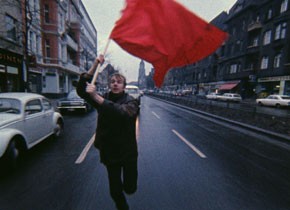Unreconciled
April 22 to May 4, 2016
Films by, with and about Holger Meins – and by Roberto Rossellini, Peter Lorre, Straub-Huillet, Walter Krüttner, Harun Farocki, Johannes Beringer, Helke Sander, Gerd Conradt, Thomas Giefer, Günter Peter Straschek, Renate Sami, Gerhard Friedl, Jean-Gabriel Périot
The works selected for this program yield a constellation of stars. The galaxy in question may seem light years away, but it concerns anyone who believes that art making can still be an oppositional practice – and that it has an existential dimension. A quote by Holger Meins could serve as an alternative headline for the program: “Everyone dies; what matters is how, and how you lived.”
Meins, who went underground as a young filmmaker and joined the RAF, was born 75 years ago. 50 years ago, in September 1966, Berlin mayor Willy Brandt inaugurated the German Film and Television Academy (dffb), whose first generation of students was to include Meins, alongside Harun Farocki, Hartmut Bitomsky, Helke Sander, Johannes Beringer, Gerd Conradt and others. “The atmosphere at the school was politically charged from the very beginning. In the aftermath of June 2, 1967, when Benno Ohnesorg was shot by the police, many students became radicalized. Several were temporarily expelled after occupying the dean’s office and symbolically renaming the institution the ‘Dziga Vertov Academy’. A number of films from this period saw themselves as direct instruction manuals for the ‘revolutionary struggle’ or raised the question of the need for violent resistance.” (Claudia Lenssen)
Austrian-born Günter Peter Straschek (1942–2009) was also part of the first dffb generation. In 1975, after attempting to put socialist filmmaking to work in numerous sectors of society, he published the Handbook against Cinema and began his decades-long research into the history of German-speaking exile filmmakers. “To find out what weighed on GPS’s mind, it is enough to hear him read the letters Arnold Schoenberg wrote to Wassily Kandinsky in Huillet & Straub’s Introduction to Arnold Schoenberg’s ‘Accompaniment to a Cinematographic Scene’: some of the demarcation and edge found there was a part of his own character.” (Johannes Beringer)
Entire libraries are devoted to the question of how post-1945 German society dealt with its pre-1945 history. Within these libraries, several shelves are dedicated to a breaking point delayed by 20 years. The aim of both the student movement and the militant groups was to raise people’s awareness of and consequently put a stop to certain explicit or subliminal continuities between the National Socialist State and post-war Germany. For the generation of Straschek, Bitomsky and Farocki, the work of Jean-Marie Straub and Danièle Huillet was an early, rare, and formative example of such a breaking point in German cinema, beginning with Machorka-Muff (1962) and Nicht versöhnt (1964/65). Their later film Moses and Aaron (1974) is dedicated to Holger Meins, by then a public enemy who had died while on hunger strike.
The German films of Italian Roberto Rossellini (Germany, Year Zero, 1948) and the returned émigré Peter Lorre (The Lost One, 1951) mark equally rare ruptures. Dealing with guilt takes center stage – a guilt that did not simply disappear in 1945, but continued and even grew in new ways. Recognizing the guilt and being able to see it (even with one’s eyes shut) brings no reconciliation here. Both films end in tragedy. But their cathartic potential was overlooked as well: they met with rejection and were hardly shown in German and Austrian cinemas.
In his film Phoenix (2014), Christian Petzold – a later dffb graduate, taught by the likes of Bitomsky and Farocki, who would become his co-author – looks back on this culture of post-war blindness. Recent films by Gerhard Friedl (1967-2000) and Jean-Gabriel Périot (b. 1974) also spin the threads from the perspective of later generations, but they do so in very different ways. Using only archival footage, Périot reconstructs A German Youth (that of the ’60s and ’70s, with a focus on the dffb between 1966 and ’68), whereas Friedl, in his Wolff von Amerongen, re-examines the economic history of Germany in the 20th century as a history of dismal continuities. The images he selects to accompany this story can be found in the landscapes of capitalism: in the present.
“The things that might come up in this conversation of ours won’t be particularly pleasant for either of us.” (Peter Lorre, The Lost One)
Straub-Huillet are at the center of a new English-language volume in the Film Museum’s book series, to be published in April and coinciding with a major touring retrospective of their films. The tour will start on May 6 at MoMA, New York, to be followed by many presentations in North America and Europe, including the Centre Pompidou in Paris.
